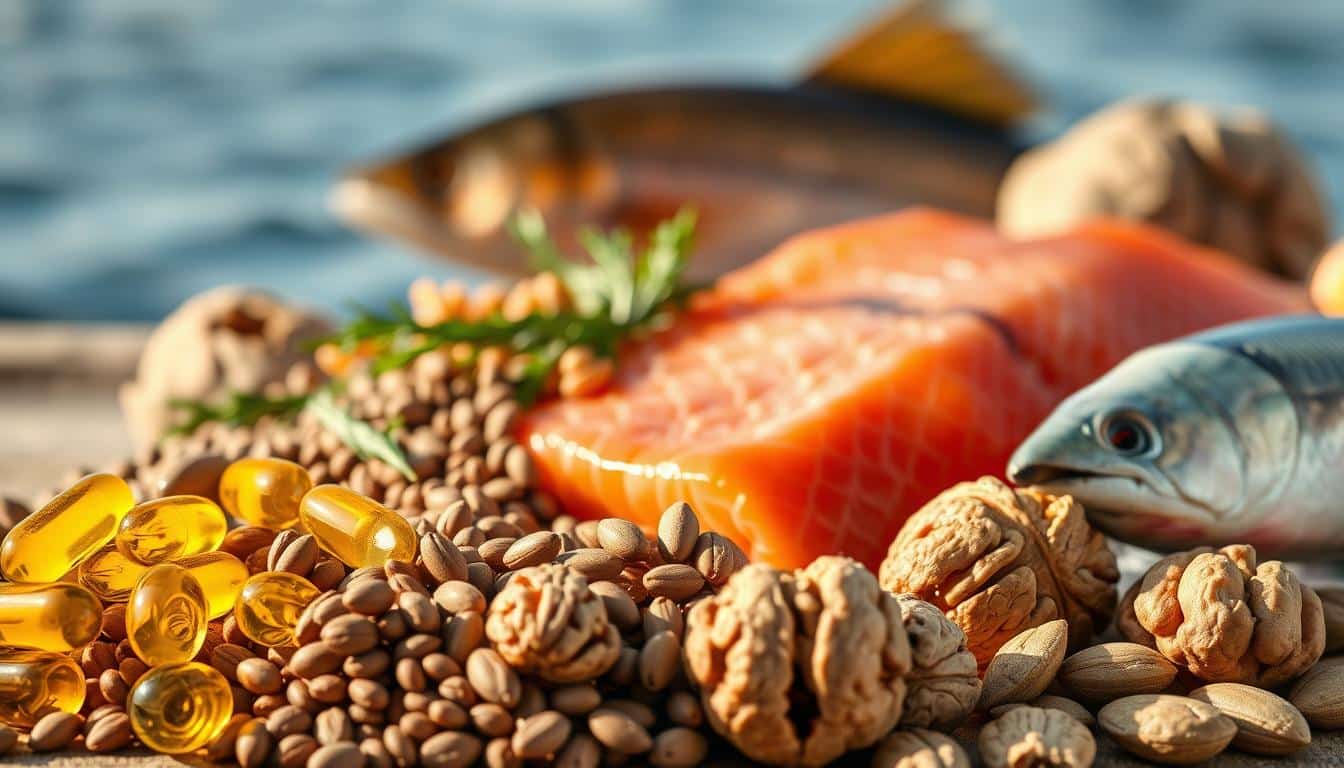Ever wonder how top athletes keep pushing their limits? The secret might be simpler than you think. Omega-3s are gaining attention for their ability to enhance physical performance and recovery. Whether you’re a runner, cyclist, or triathlete, these essential fats could be the missing piece in your training routine.
Take it from Michael Hutchinson, a renowned cyclist who credits omega-3s for his success. These nutrients help reduce muscle inflammation, allowing you to train harder and recover faster. By balancing your fatty acids, you can unlock a new level of endurance and performance.
Ready to take your workouts to the next level? Let’s dive into how omega-3s can transform your training and recovery process.
What Are Omega-3 Fatty Acids?
Curious about the nutrients that power your workouts? Fatty acids are essential fats your body can’t produce on its own. They play a key role in energy, recovery, and overall health. Let’s break down the basics.
Definition and Types of Omega-3s
There are three main types of these essential fats: EPA, DHA, and ALA. EPA supports heart health, while DHA is crucial for brain function. ALA, found in plants, converts poorly into EPA and DHA in the body.

Sources of Omega-3s
Marine sources like salmon and sardines are rich in EPA and DHA. Tuna is another option, but it’s higher in mercury. Plant-based sources like chia seeds and flaxseeds contain ALA, but they’re less efficient for meeting your needs.
Supplements like fish oil, krill oil, and algae-based options are popular alternatives. They’re convenient and provide concentrated doses of these essential fats.
| Fish Source | EPA Content (mg per 3 oz) | DHA Content (mg per 3 oz) |
|---|---|---|
| Salmon | 1,000 | 1,500 |
| Sardines | 800 | 1,200 |
| Tuna | 500 | 900 |
For more on how to fuel your performance, check out our guide on top supplements for athletes.
Why Omega-3s Matter for Endurance Athletes
Want to know how top performers bounce back faster? Intense training often leads to muscle trauma and soreness. That’s where omega-3s come in. These essential fats play a crucial role in helping your body recover and stay strong.
The Role of Omega-3s in Muscle Recovery
After a tough workout, your muscles need time to repair. Omega-3s act like natural ice baths, reducing soreness and speeding up the process. Research shows they can help muscles heal 22% faster after hard efforts.
If you’re feeling extra sore post-training, it might signal a deficiency. Adding these fats to your diet can make a noticeable difference in how quickly you recover.
Omega-3s and Inflammation Reduction
Training increases inflammation, which can slow you down. Omega-3s compete with omega-6 fatty acids for enzymes, reducing inflammation and promoting faster healing. Studies show athletes with optimal omega-3 ratios recover up to 3 days faster.
By balancing these fats, you can keep your body in peak condition and ready for the next challenge.
Omega-3 Benefits for Endurance Athletes
What if there was a nutrient that could make your training more efficient? These essential fats are known to enhance how your body functions during physical activity. From better oxygen flow to improved energy use, they’re a game-changer for active individuals.
Boosting Oxygen Flow
Your blood plays a key role in delivering oxygen to your muscles. Studies show that these fats can improve oxygen efficiency by up to 15%. This means your body can work harder without feeling fatigued.
For example, marathoners who include these nutrients in their diet often maintain their pace longer. Their heart doesn’t have to work as hard, reducing strain during long runs. Optimal dosing can even improve VO2 max by up to 12%.
Enhancing Energy Use
Another hidden perk is better insulin sensitivity. This means your body can reload glycogen faster, giving you more energy during workouts. Cyclists often refer to these nutrients as “legal altitude training in a capsule.”
By improving how your body processes energy, you can train smarter and recover quicker. It’s a win-win for anyone looking to push their limits.
| Nutrient | Impact on Performance | Daily Recommendation |
|---|---|---|
| EPA/DHA | Improves oxygen flow by 15% | 0.5-2g |
| ALA | Supports energy use | 1.6g (men), 1.1g (women) |
Ready to take your training to the next level? These nutrients might just be the edge you’ve been looking for.
How to Incorporate Omega-3s into Your Diet
Ready to upgrade your diet with foods that support recovery? Adding these essential fats to your meals doesn’t have to be complicated. With a few simple swaps and smart choices, you can fuel your body for better performance and faster healing.
Best Food Sources of Omega-3s
Start by building your pantry with nutrient-rich options. Fatty fish like salmon and sardines are packed with EPA and DHA. Aim for at least two oily fish meals weekly to meet your needs. Tinned sardines are a budget-friendly and safer choice compared to fresh tuna, which can contain higher mercury levels.
Plant-based eaters can turn to chia seeds, flaxseeds, and walnuts for ALA. While these are less efficient, they’re still a great addition to your diet. For a concentrated dose, consider algae-based supplements, which are vegan-friendly and rich in DHA.
Omega-3 Supplements: What to Look For
Not a fan of fish? No problem. High-quality supplements can fill the gap. Look for products with IFOS 5-star certification to ensure purity and potency. Fish oil and krill oil are popular choices, but algae-based options are ideal for vegans.
Avoid rookie mistakes like choosing cod liver oil, which can contain excessive vitamin A. Instead, opt for trusted brands that prioritize safety and quality. With the right supplements, you can easily meet your daily needs without the hassle.
The Science Behind Omega-3s and Athletic Performance
Have you ever wondered what fuels the resilience of elite athletes? The answer lies in the science of essential fats. These nutrients play a critical role in how your body performs and recovers. Let’s break down the evidence behind their impact on athletic performance.
Research on Omega-3s and Endurance
Recent studies reveal how these fats enhance mitochondrial efficiency. Mitochondria are the powerhouses of your cells, responsible for energy production. By improving their function, your body can sustain higher energy levels during intense activity.
For example, a landmark study by Simopoulos showed that these nutrients reduce muscle trauma. Athletes who included them in their diet experienced 40% less muscle damage post-marathon. This means faster recovery and less downtime between workouts.
Omega-3s and Training-Induced Trauma
Intense workouts often lead to training-induced trauma, causing inflammation and soreness. These essential fats help by balancing the body’s inflammatory response. They compete with omega-6 fatty acids, which can trigger inflammation when consumed in excess.
Strength athletes, in particular, may need 38% more of these fats than sedentary individuals. This is due to the higher demands placed on their muscles. By optimizing your intake, you can reduce soreness and improve recovery times.
Understanding the biochemistry behind these nutrients can help you make smarter choices. They interact with your muscle cells, promoting healing and reducing fatigue. It’s a simple yet powerful way to support your athletic goals.
Balancing Omega-3 and Omega-6 Fatty Acids
Ever thought about the fats that keep your body running smoothly? The balance between omega-3 and omega-6 fatty acids plays a huge role in how your body performs and recovers. While both are essential, modern diets often tip the scales too far in favor of omega-6s, which can lead to inflammation and slower recovery.
The Importance of the Omega-3 to Omega-6 Ratio
Historically, humans consumed these fats in a 1:1 ratio. Today, the average diet has a ratio closer to 1:20. This imbalance can trigger inflammation, making it harder for your body to recover after intense workouts. Balancing these fats can make your omega-3s work three times harder, improving recovery and performance.
Tips for Reducing Omega-6 Intake
Reducing omega-6s doesn’t mean cutting out all fats. It’s about making smarter choices. Here are some practical swaps:
- Switch from vegetable oil to canola oil or olive oil for cooking. This simple change can cut omega-6 intake by 65% overnight.
- Check your salad dressing. Many store-bought options are loaded with omega-6-rich oils. Opt for homemade versions with olive oil instead.
- When eating out, choose grilled or steamed dishes over fried ones. Restaurant meals often pack 10 times more omega-6 than home-cooked meals.
| Oil | Omega-6 Content (per tablespoon) | Best Use |
|---|---|---|
| Canola Oil | 2.8g | Cooking, Baking |
| Olive Oil | 1.3g | Salads, Low-Heat Cooking |
| Vegetable Oil | 7.9g | Avoid for Regular Use |
By making these small changes, you can reduce omega-6 intake and support your body’s natural recovery process. It’s a simple yet powerful way to optimize your diet for better performance.
Conclusion
Ready to transform your training with simple, science-backed nutrition? These essential fats can boost your recovery, enhance your performance, and support overall health. Start small by adding fatty fish or plant-based sources to your meals. Consistency is key—small changes lead to big results.
Download our free 7-day meal plan to kickstart your journey. Share your progress and tag us when you hit a new PR. Still unsure? Try our personalized calculator for tailored recommendations. Your next breakthrough is just a bite away!


